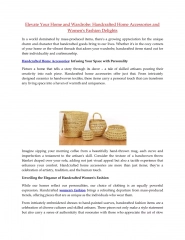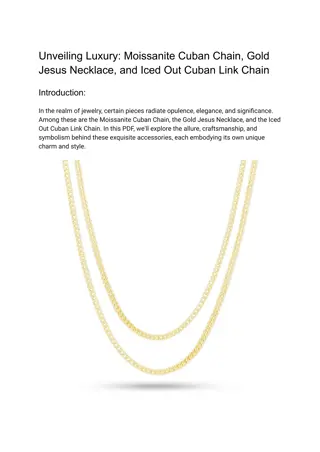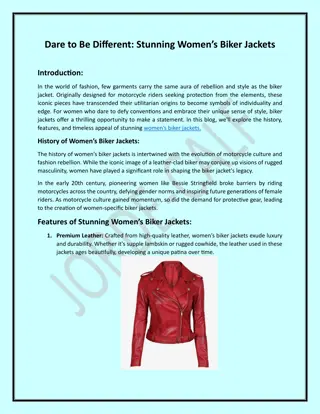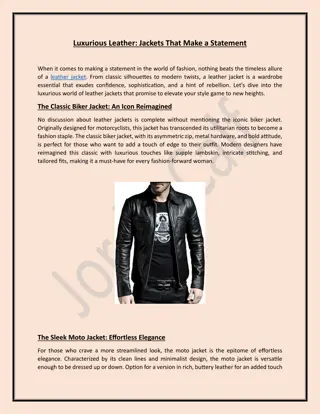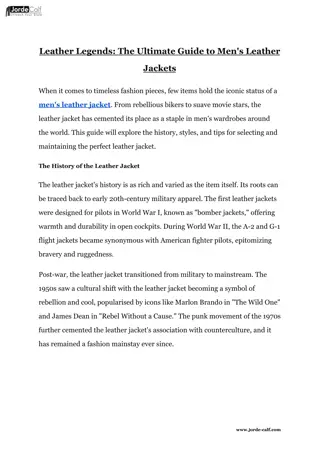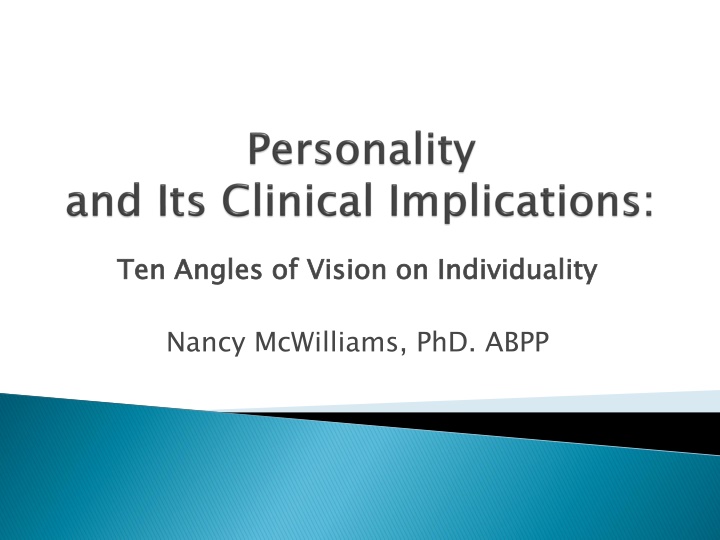
Insights into Individuality and Attachment Theory
Dive deep into the complex notions of individuality and attachment theory with a curated collection of seminal works by renowned authors such as Nancy McWilliams, John Bowlby, and Sigmund Freud. Explore temperament, behavior disorders, and psychoanalytic perspectives on personality development. Gain a comprehensive understanding of ego defense mechanisms, cognitive therapy, and the psychoanalytic process.
Download Presentation

Please find below an Image/Link to download the presentation.
The content on the website is provided AS IS for your information and personal use only. It may not be sold, licensed, or shared on other websites without obtaining consent from the author. If you encounter any issues during the download, it is possible that the publisher has removed the file from their server.
You are allowed to download the files provided on this website for personal or commercial use, subject to the condition that they are used lawfully. All files are the property of their respective owners.
The content on the website is provided AS IS for your information and personal use only. It may not be sold, licensed, or shared on other websites without obtaining consent from the author.
E N D
Presentation Transcript
Ten Angles of Vision on Individuality Ten Angles of Vision on Individuality Nancy McWilliams, PhD. ABPP
Thomas, A., Chess, S., & Birch, H. G. (1968). Temperament and behavior disorders in children. New York: International Universities Press. Escalona, S. K. (1968). The roots of individuality: Normal patterns of development in infancy. Chicago: Aldine. Kagan, J. (1994). Galen s prophecy: Temperament in human nature. New York: Basic Books.
Bowlby, J. (1969). Attachment and loss: Vol 1: Attachment. New York: Basic Books. Bowlby, J. (1973). Attachment and loss: Vol 2: Separation: Anxiety and anger. New York: Basic Books. Fonagy, P. (2001). Attachment theory and psychoanalysis. New York: Other Press. Holmes, J. (2001). The search for the secure base: Attachment theory and psychotherapy. Philadelphia: Taylor & Francis. Mikulincer, M., & Shaver, P. R. (2007). Attachment in adulthood: Structure, dynamics, and change. New York: Guilford Press. Wallin, D. J. (2007). Attachment in psychotherapy. New York: Guilford Press.
Freud, S. (1916). Some character types met with in psychoanalytic work. Standard Edition, 14, 311-333. Reich, W. (1933). Character analysis. New York: Farrar, Straus, & Giroux. Fenichel, O. (1945). The psychoanalytic theory of neurosis. New York: Norton. Shapiro, D. (1965). Neurotic styles. New York: Basic Books. MacKinnon, R. A., & Michels, R. (1971). The psychiatric interview in clinical practice. Philadelphia: Saunders. Kernberg, O. F. (1984). Severe personality disorders: Psychotherapeutic strategies: New Haven, CT: Yale University Press. McWilliams, N. (1994, rev. ed. 2011). Psychoanalytic diagnosis: Understanding personality structure in the clinical process. New York: Guilford.
Freud, A. (1936). The ego and the mechanisms of defense. New York: International Universities Press. Laughlin, H. P. (1970). The ego and its defenses. New York: Jason Aronson. Vailliant, G. E. (1992). Ego mechanisms of defense: A guide for clinicians and researchers. Washington, DC: American Psychiatric Association. Cramer, P. (2006). Protecting the self: Defense mechanisms in action. New York: Guilford.
Weiss, J., Sampson, H., & the Mt. Zion Psychotherapy Research Group (1986). The psychoanalytic process: Theory, clinical observations, and empirical research. New York: Guilford. Weiss, J. (1993). How psychotherapy works: Process and technique. New York: Guilford. Beck, J. S. (1995). Cognitive therapy: Basics and beyond. New York: Guilford. Silberschatz, G. (Ed.) (2005). Transformative relationships: The control-mastery theory of psychotherapy. New York: Routledge.
Tomkins, S. S. (1995). Script theory: In E. V. Demos (Ed.), Exploring affect: The selected writings of Silvan Tomkins (pp. 312-388). New York: Cambridge University Press. Panksepp, J. (2004). Affective neuroscience: The foundations of human and animal emotions. New York: Oxford University Press. Panksepp, J., & Biven, L. (2012). The archeology of mind: Neuroevolutionary origins of human emotions: New York: Norton. Anstadt, Th., Merten, J., Ullrich, B., & Krause, R. (1997). Affective dyadic behavior, core conflictual relationship themes and success of treatment. Psychotherapy Research, 7, 397-417.
Solms, M., & Turnbull, O. (2002). The brain and the inner world: An introduction to the neuroscience of subjective experience. New York: Other Press. Fisher, H. (2005). Why we love: The nature and chemistry of romantic love. New York: Henry Holt & Co. Fisher, H. (2010). Why him? Why her? Finding real love by understanding your personality type. New York: Henry Holt & co.
Jung, C. G., & Baynes, H. G. (1921). Psychological types or the psychology of individuation. London: Kegan Paul. Balint, M. (1945). Friendly expanses Horrid empty spaces. International Journal of Psycho-Analysis, 36, 225-241. Blatt, S. J. (2008). Polarities of experience: Relatedness and self-definition in personality development, psychopathology, and the therapeutic process. Washington, DC: American Psychological Association.
Fairbairn, W. R. D. (1952). An object-relations theory of the personality. New York: Basic Books. internalized object relations French, T. (1958). The integration of behavior, vol. 3. The reintegrative process in a psychoanalytic treatment. Chicago: University of Chicago Press. repetitive structures Bowlby, J. (1969. Attachment and loss: Vol. 1: Attachment. London: Hogarth. inner working models Malan, D. H. (1976). The frontier of brief psychotherapy. New York: Plenum. nuclear conflicts Stern, D. N. (1985). The interpersonal world of the infant: A view from psychoanalysis and developmental psychology. New York: Basic Books. representations of internalizations that have been generalized (RIGs) Dahl, H. (1988). Frames of mind. In H. Dahl, H. Kachele, & H. Thomae (Eds.). Psychoanalytic process research strategies (pp. 51-66). New York: Springer-Verlag. fundamental and repetitive emotional structures (FRAMES)
Aron, L. (1991). Working through the pastworking toward the future. Contemporary Psychoanalysis, 27, 81-108. internal relational models Tomkins, S. S. (1995). Script theory In E. V. Demos (Ed.), Exploring affect: The selected writings of Silvan Tomkins (pp. 312-388). New York: Cambridge University Press. nuclear scenes Bucci, W. (1997). Psychoanalysis and cognitive science. New York: Guilford. emotion schemas Luborsky, L., & Crits-Cristoph, P. (1996). Understanding transference (2nded.). Washington, DC: American Psychological Association: core conflictual relationship theme Lyons-Ruth, K. (1999). The two-person unconscious: Intersubjective dialogue, enactive relational representation, and the emergence of new forms of relational organization. Psychoanalytic Inquiry, 19, 576-617. implicit relational knowing Horowitz, M. (1998). Cognitive psychodynamics. New York: Wiley. personal schemas Young, J. E., Klosko, J. S., & Weishaar, M. E. (2006). Schema therapy: A practitioner s guide. New York: Guilford. individual schemas
Freud, S. (1905). Three essays on the theory of sexuality. Standard Edition, 7, 135-243. Klein, M. (1935). A contribution to the psychogenesis of manic- depressive states. In Love, guilt and reparation and other works 1921-1945 (pp. 262-289). New York: Free Press. Erikson, E. H. (1950). Childhood and society. New York: Norton. Kernberg, O. F. (1984). Severe personality disorders: Psychotherapeutic strategies. New Haven, CT: Yale University Press. Mahler, M. S., Pine, F., & Bergmann, A. (1985). The psychological birth of the human infant. New York: Basic Books. Bateman, A., & Fonagy, P. (2004). Mentalization-based treatment for borderline personality disorder. New York: Oxford University Press.

